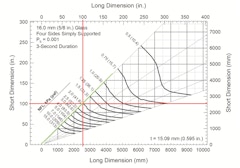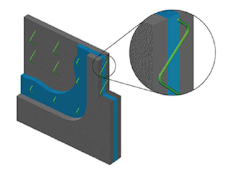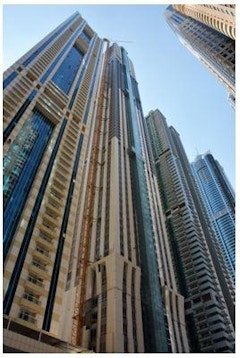27 results
-
As we change the rules of thermal performance for facades, we are changing the conditions the glass is subject to in shadow boxes and glazed spandrel…
-
Balustrade Design Loads
- Paper by Richard Green, SE, PE, P.Eng, CPEng, IntPE, APEC Engineer, M.ASCE M.IEAust · Andrew Crosby PEng · Terrence McDonnell
A review of balustrade practices from around the world, and why practices in United States and countries using ICC code/ASCE 7 designs are failing to
-
A Structural Glass Design Manual
- Paper by Richard Green PE SE P.Eng CPEng IntPE(Aust) APEC Engineer, Principal / Owner Terrence McDonnell S.E., P.E., P.Eng., SECB, Principal Andrew Crosby BASc, P.Eng., LEED® AP BD+C, Principal
Other than limited special cases, there is a lack of standards providing guidance on the design of structural glass. This has resulted in an ad-hoc… -
Glass Balustrade Design
- Paper by Richard Green, PE, SE, P.Eng, CPEng IntPE(Aust), APEC Engineer · Andrew Crosby, PEng · Terrence McDonnell S.E., P.E., P.Eng., SECB
Glass handrail design in the United States lags behind best practice in other parts of the world. There can be as much as a factor of four (4)
-
The Scope of the Structural Glass Design Manual
- Paper by Richard Green SE PE P.Eng CPEng · Andrew Crosby P.Eng LEED® AP BD+C · Terrence McDonnell SE SECB PE P.Eng
The technology of glass now allows glass to be fabricated in sizes and structural configurations not previously conceivable. The standards and codes
-
EVA Interlayers in Hardened Facades
- Paper by Nicholas Oberts, PE · Mark K. Weaver, PE, SE · Phillip Benshoof, PE
Explosions can result in very high loads of extremely short durations. Protective design to mitigate the effects of blast loading requires façade
-

Control Tower Glass Design
- Paper by Daniel McCormick, P.E., PMP, M.ASCE · Stephen M. Morse, Ph.D., P.E., M.ASCE · Scott H. Norville, Ph.D., P.E., F.FTI, F.ASTM, F.ASCE
ASTM published the first version of ASTM E2461-05: Standard Practice for Determining the Thickness of Glass in Airport Traffic Control Tower Cabs in
-
Laminated Security Glazing
- Paper by Vaughn Schauss,
Glass is an essential component for any type of building. Its transparency enhances daylighting and provides occupants a view to the outside. Whether… -

More Than a Facade
- Paper by Edward Losch · Marc Maguire
In 2014, the American National Standards Institute (ANSI) approved the Precast/Prestressed Concrete Institute (PCI) as an accredited ANSI Standards
-
When Facades Kill
- Paper by Terri Meyer Boake
The tragic fire of June 14, 2017 at the Grenfell Tower in London, England has brought to a very public global forum issues related to the impact of
-

Subjective Perception and Objective Measurement
- Paper by Caroline Lama, Antonio Luz, Ashley Reed,
Current glass industry standards provide clear tolerances for readily quantifiable physical properties to assist with the evaluation of visual… -

Specifying Commercial Aluminum Finishes
- Paper by Ben Mitchell, MBA,
Many factors will influence coating selection, but to achieve the desired performance level for a given situation, coatings must be specified based… -

Silicone Spandrel Glass Opacifiers
- Paper by Scott Norville · Samir Blanchet · George Torok · Kris Vockler · John Swanson · Chris Barry · Lawrence Carbary · Stephane Hoffman · Timothy Krytenberg · Chris Fronsoe
Curtain wall design commonly uses insulating glass units for vision and spandrel glazing to provide better visual harmonization of building facade
-

Lightning Protection as Building Envelope
- Paper by Jennifer Morgan, Michael Chusid, RA FCSI CCS,
A building’s envelope mitigates the effects of meteorological phenomena – including lightning – upon the structure and its occupants and contents.… -

Fire Safety in High Rise Exterior Facades
- Paper by Angela M. Ogino,
One of the most complex yet least understood areas where fire can spread is at the perimeter of a building. Fire can not only spread from… -

EUI of Building Clusters
- Paper by Srinivas M. Rao, AIA, AICP, LEED AP
Large master planned developments such as Battery Park City in Manhattan, Mission Bay in San Francisco, and Playa Vista in Los Angeles were built
-

Deconstructing the Window
- Paper by Helen Sanders · Jörg Lenz · Petra Sommer
Over the years, the industry has relied heavily on the increasing performance of low-e coatings to drive window U-factors (thermal transmittance)
-

The Seismic Capability of Curtainwalls
- Paper by Peter Lalas MIEAust CPEng NER APEC Engineer IntPE(Aus), Principal Facade Engineer
The testing of aluminum/glass curtainwalls for seismic capability, mainly inter-story drift, has been carried out on many curtainwalls over the last… -

Fire Safety and Code Challenges for Mass Timber in Curtain Wall Systems
- Paper by David Barber · John Neary · Mic Patterson PhD LEED AP+
With the desire for more sustainable construction and reduced embodied energy, mass timber is being explored for building structures. For medium and
-

U-Factor Matters in Hot Climates
- Paper by Helen Sanders, PhD, General Manager
It is commonly thought that fenestration U-factor is not a key determinant in the performance of facades in hot climates, and generally the focus of…
